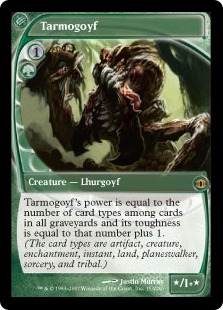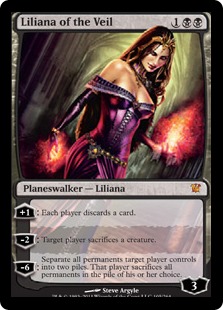Not All Reprints Are Created Equal
This week, reprints are at the top of everyone's mind as previews for Masters 25 roll out day by day. The set itself has been a bit of a roller coaster, starting off strong with Jace, the Mind Sculptor being spoiled at Pro Tour Rivals of Ixalan and then ending with a whimper as Tree of Redemption was revealed to be one of the final mythics in the set. The good and bad of Masters 25 have already been covered ad nauseam on Reddit and social media, so writing an article saying that the set looks super sweet and but the value seems to be inconsistent at best and bad at worst (considering a pack is $10 MSRP) wouldn't really add much to the conversation.
So today, rather than rehash the generalities of Masters 25, we're instead going to jump into one specific topic that is very much related to the mixed reviews from the set: reprints. More specifically, what makes some reprints better than others? Now here, you're probably thinking this is obvious—Magic cards are worth money, so cards that are worth more money are better reprints. Unfortunately, this isn't always the case, and reality is a bit more complex. Not all reprints are created equal. There can be two cards worth the exact same amount in terms of real dollars, and one can be a significantly better reprint than the other.
The reason this topic is relevant is that Masters 25 is overflowing with cards that, in terms of pre-reprint value, are worth a reasonable amount of money in real dollars, but most of these cards aren't actually all that compelling as reprints. As we move away from Modern-focused Masters sets into a world of themed Masters sets, these types of reprints are going to be more and more common, so it's important that we understand the underlying mechanisms that make a reprint good or bad. Let's start with a very simple case that illustrates the point quite well.
The Example: Jace vs. Imperial Recruiter


In Masters 25, the two highest-value mythics are Jace, the Mind Sculptor and Imperial Recruiter. Before the Masters 25 reprinting, both cards were worth around $150 (Imperial Recruiter perhaps a little more, depending on the edition). While these cards might look equally desirable in terms of being reprinted, they are actually worlds apart.
When it comes to the price of a Magic card, there are two primary drivers: supply and demand. This is basic economics. However, when you look at expensive Magic cards, you can roughly divide them into two groups: cards that are expensive because they are low in supply, and cards that are expensive because they are high in demand. While this is most definitely an over-simplification, it's close enough for our purposes today.
Cards that are low in supply don't really need that much demand to be expensive. A great example of this is the Power Nine. There simply aren't many copies of Black Lotus and Mox Pearl in existence, which means that even though 99% (or more) of Magic players aren't looking to buy a copy, these cards can maintain a massive price tag just from the demand generated by the 1% (or fewer) who are in the market and looking to buy copies of the cards.
On the other hand are cards that are expensive because they have a lot of demand. Modern staples like Liliana of the Veil and Standard staples like The Scarab God can have a reasonably high supply while still being expensive (for example, there are way more Liliana of the Veils in existence than Mox Pearls). Of course, it's also true that a card can have so much supply that no matter how much demand it has, it's hard for the price to increase (while most commons and uncommons are good examples of this, the best example is basic lands: every Magic player needs them, which means basic lands have more demand than any other card in Magic, but they are often given away for free because they have such absurdly high supply).
When it comes to reprints in sets like Masters 25, the best reprints are expensive because they are in demand. This is why cards like Tarmogoyf can be reprinted over and over again and still maintain a reasonable amount of value. Lots of Magic players want a playset of Tarmogoyf in their collections. On the other hand, reprints that are expensive because they are low in supply are the equivalent of fool's gold. It looks exciting when you see that a $200 Imperial Recruiter is being reprinted, but when you think about the amount of demand that exists for Imperial Recruiter, the reprint becomes much less desirable and valuable.
To bring this back around to Jace, the Mind Sculptor and Imperial Recruiter, they provide a good example of why demand matters for reprints. For the sake of this example, let's assume that both cards were $150 before the reprinting (again, Imperial Recruiter was probably a little bit higher, but close enough). Right now, at the end of spoiler week, Jace, the Mind Sculptor is still $136, barely dropping at all in price. Meanwhile, Imperial Recruiter is under $70 and falling.
The reason for this is that Jace, the Mind Sculptor might have the most demand of any card in Modern at the moment thanks to its recent unbanning. Even long-time Modern players with big collections need copies to play their favorite format (we could have an entire article on how reprints actually increase demand to some extent, but that's a bit outside the scope of today's article). As for Imperial Recruiter, I'm not sure who actually needs copies. There are probably a handful of Commander players who want a single copy, and maybe a a few people will use the lower price tag of Imperial Recruiter as an excuse to buy into Legacy with Aluren or Painter's Servant, but no matter how you break it down, the number of Magic players who want a copy or copies of Imperial Recruiter is close to non-existent compared to the number of Magic players who want a copy or copies of Jace, the Mind Sculptor. This is why Jace, the Mind Sculptor has barely dropped in price at all over the past week, while Imperial Recruiter is more than 50% off of its pre-reprint price in just a couple of days.
Masters 25




One of the reasons this topic is so timely is that Masters 25 is overflowing with cards that are expensive primarily because they are low in supply, not because they are high in demand. For instance, the filter lands. While they are nearly as expensive as the fetch lands in terms of real dollars, this is simply because they are from a relatively low-supply set and have never been reprinted. Apart from a handful of Commander players and some extremely fringe Modern decks (typically ones with very taxing mana costs, like GB Midrange with Phyrexian Obliterator), no one really needs the filter lands. They rank behind fetch lands, shock lands, fast lands, and sometimes even the buddy lands in terms of Modern playability, and they aren't played in Legacy or legal Standard, which means the demand just isn't there. Now, I should make this very clear: this doesn't mean that filter lands are bad reprints. Having a card you really want for your Commander deck go from $30 to $10 is a good thing. The problem is that it makes the filter lands lacking in terms of selling Masters 25.




Being overloaded with low-demand, low-supply cards is Masters 25's biggest problem. You can count the number of expensive and in-demand cards on both hands. In the mythic slot are Jace, the Mind Sculptor, Ensnaring Bridge, Chalice of the Void, Vendilion Clique, and perhaps Animar, Soul of Elements (which is one of the top 20 Commanders, so even though the Elemental doesn't see play in any tournament formats, a lot of people are going to want copies), and in the rare slot are Blood Moon, Rishadan Port, (maybe?) Thalia, Guardian of Thraben, Eidolon of the Great Revel, Rest in Peace, and perhaps Pact of Negation and Summoner's Pact. The two Pacts are strange. They do see play in Modern, but they are much more restricted in terms of archetypes than the other cards on the list, with both primarily showing up in just one archetype: Primeval Titan decks for Summoner's Pact and Ad Nauseam (along with a couple of even more fringe combo decks) for Pact of Negation.
The problem with filling a Masters set with expensive but low-demand cards is twofold. First, as I mentioned before, cards that are expensive because they are low in supply are fool's gold, and prices are going to drop significantly. While this isn't a bad thing from the perspective of the handful of people who want to pick up copies of these cards (actually, from this perspective, it's a great thing), it does mean that the expected value of booster boxes and packs is going to crumble over the coming weeks, which is going to make it even harder for people to draft the very sweet-looking Masters 25 set because the drafts will be prohibitively expensive.
Second, and perhaps more important to constructed players, filling a set with low-supply reprints means that the handful of good (or high-demand) reprints we talked about a moment ago—the Jace, the Mind Sculptors, Chalice of the Voids, and Thalia, Guardian of Thrabens—aren't going to lose all that much value. The less in-demand cards will drop in price a ton, and the in-demand cards won't drop much at all. The end result is a Masters set that doesn't actually do much of anything in terms of making formats like Modern and Legacy more affordable.
Just take a look at Iconic Masters. You can pick up Auriok Champion for $5 instead of $30, but that's because a very limited number of people actually need copies of Auriok Champion. The same is true of Glimpse the Unthinkable, Flusterstorm, Mana Drain, and a ton of other cards that were expensive because they were low in supply rather than high in demand. The problem is that because not many people actually need these cards to play tournament formats, having them cheaper isn't actually all that helpful if the goal is to make formats like Modern and Legacy more accessible. Yes, it's great that they cost less if you want one for Commander or to build UB Mill or weird Soul Sisters for FNM, but in the grand scheme of things, this doesn't actually make Magic all that much cheaper.
To really make an impact on the cost of playing a format like Modern or Legacy, a Masters set needs to reduce the cost of the cards that you actually need to play that format, and this is where Iconic Masters failed. Cryptic Command is essentially the same price as before it was reprinted in Iconic Masters, and the same is true of Thoughtseize, Aether Vial, and Supreme Verdict. While the set did do a good job of dropping the cost on cards like Horizon Canopy, that's because the previous $80 price tag on the land was more about the fact it was low in supply than high in demand, despite the fact that it does show up in some Modern decks.
When a Masters set contains too much low-supply reprints, the end result is that low-demand cards lose value because few people actually want to buy copies, while the high-demand cards that people really need to play the game end up relatively unscathed.
Moving Forward
I talk a lot about Wizards running low on reprint equity, but it's important to mention it again here one more time because it is relevant to our discussion. Another problem with reprinting the Imperial Recruiters and Mana Drains of the world is that, unlike the Tarmogoyfs and Liliana of the Veils of the world, you can only reprint them once or twice before they lose most of their value as reprints, which means rather than going back to the same well over and over again like you can with high-demand cards, with low-supply, low-demand reprints, Wizards can only reprint them once or twice before they lose all of their reprint equity. The fact that Wizards is down to using Imperial Recruiters and Mana Drains to sell sets rather than Tarmogoyfs and Liliana of the Veils is another sign that Wizards is worried about the pressure constant Modern reprints are having on its ability to continue to sell Masters sets.



With Wizards moving away from focusing on formats like Modern with Masters sets and toward themes, you can expect that this will open the door to a lot of low-supply reprints, with random old Portal cards being used as the chase cards in Masters sets (like Grim Tutor and Ravages of War), along with whatever Legacy cards of value Wizards can scrape together that aren't on the reserved list already. Moving to this model means that Wizards needs to be extra aware of how much value it is putting into sets because counting Imperial Recruiter as a $200 card in internal, set-building EV calculations is Wizards buying its own fool's gold. If Wizards is going to use low-supply reprints to sell sets, it is going to need to double the amount of value it puts into the set to account for how quickly the prices of these cards will drop. While Imperial Recruiter and Mana Drain can't sell a set on their own because they are $50 cards hiding behind $200 price tags, perhaps Imperial Recruiter, Mana Drain, and Grim Tutor together would be enough to keep the value of a set at a reasonable level.




The most likely explanation for the lacking expected value of both Iconic Masters and Masters 25 is that Wizards simply didn't take into account the fact that not all reprints are created equal. For the past several years, Wizards had successful Masters sets simply by stuffing them full of high-demand Modern staples and making sure that the expected value hit a reasonable level (while Wizards will never publicly address card values, it would be shocking if Wizards didn't calculate expected values internally and use them to guide some of its reprint decisions in Masters sets). Then, for Iconic Masters and Masters 25, Wizards used the same formula but replaced Tarmogoyf and Liliana of the Veil with Imperial Recruiter and Mana Drain, perhaps without taking demand into consideration. The end result is prices (predictably, for people who know and follow Magic finance) dropping more than Wizards expected, which left the sets with a lacking overall expected value.
Apart from simply including more value in Masters sets to compensate for the fact that low-supply, low-demand cards drop way more in price upon reprinting than high-demand cards, the other option for Wizards is to simply reduce the cost of Masters sets back to the original $7. We talked about this at length last week, so I'm not going to spend too much time on the topic here, but Masters 25 is the second set in a row that is lacking from an expected value perspective, at a $10 / pack price point. Not only would dropping the MSRP make it easier to sell sets with low-supply reprints, since Wizards wouldn't need as much total value to keep the expected value reasonable, but dropping MSRP could generate more demand for the set, as players who are priced out of drafting (or drafting multiple times) at $30 or even $45 a draft could potentially draft several times at $20–$25 a draft. At $25 a draft, you can chalk up the experience as a cost of entertainment, just like going to the movies. At $45, it's a bit harder to simply write off a Masters set draft as three hours of fun, when you could purchase a video game that you could play for hundred of hours for around the same price.
Hopefully, Wizards figures out a solution to its Masters set problem quickly because I'm afraid that Wizards is running out of time from the perspective of local game stores. While most people probably don't realize this, small local game stores pay nearly $140 for a box of a Masters set, which means if Masters 25 follows Iconic Masters (with boxes selling for $130–$140 on the Internet), this will be the second Masters set in a row for which stores have either lost money or just broken even. This isn't sustainable, especially for small stores, which run on super tight margins.
The bottom line is this: Masters 25 looks like a great draft set, and Wizards' impulse—that great limited formats are a large part of what players want from Masters sets—is correct. The problem is that you can make the greatest limited format in the history of Magic, but it won't matter if players can't afford to play it and local game stores aren't around to host the draft.
Conclusion
Anyway, that's all for today. Make sure to check back next Sunday for a full expected-value breakdown of Masters 25! Until then, what's your initial take on Masters 25? Are you going to buy a box? Play some drafts? Let me know in the comments! As always, leave your thoughts, ideas, opinions, and suggestions, and you can reach me on Twitter @SaffronOlive or at SaffronOlive@MTGGoldfish.com.













